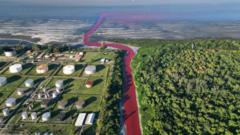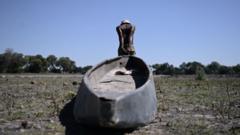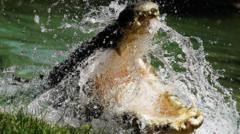Residents of Nordelta, Argentina, tackle the growing capybara population as veterinarians sterilize these beloved yet multiplying rodents, highlighting the balance between wildlife and urban living.
**Capybara Conundrum: Argentina's Struggle with Overpopulation of the World's Largest Rodent**

**Capybara Conundrum: Argentina's Struggle with Overpopulation of the World's Largest Rodent**
Amid the charm of capybaras lies a unique problem in an exclusive Buenos Aires community dealing with their rapid population growth.
Luciano Sampietro aimed his blow dart at a robust capybara lounging by an artificial pond in Nordelta, a gated community located just north of Buenos Aires. With a skilled puff, he delivered a sedative cocktail to the capybara, marking yet another attempt to control the burgeoning population of these gentle giants. The veterinarian's objective was clear, as he carefully targeted a hefty alpha male, while a nearby female succumbed to the sedative, only to reveal she was already pregnant—complicating the full impact of their efforts.
This neighborhood, renowned for its wealth and exclusivity, finds itself amidst a quirky predicament involving the world’s largest rodent, the capybara. Despite their amicable nature and charming demeanor, these creatures have surged in numbers, leading the community to confront the consequences of having too many capybaras.
Capybaras, weighing around 110 pounds, have captured the hearts of many on social media. They are often found in videos showcasing their calm disposition, frequently interacting with a variety of animals, from monkeys to ducks. Their popularity has inspired various merchandise, including toys and coffee shop experiences, where patrons can feed these friendly creatures.
However, with their numbers rapidly increasing, Nordelta's residents face a challenge. Historical satellite imagery illustrates the extensive changes to the area from 1995 to 2020, transforming natural habitats into a residential marvel. Unfortunately, the conversion has also disrupted the local ecology, bringing about an unanticipated influx of capybaras into their upscale community.
Compounding the issue, residents find themselves divided. While some cherish the friendly interactions with the capybaras, others express concern over their rapid population growth and the need for intervention. The community's solution has been to enlist veterinarians for sterilization attempts, striving to find harmony between human habitation and wildlife preservation.
In attempts to maintain control over the capybara situation, Nordelta serves as a prime example of the challenges faced when urban development encroaches upon wildlife habitats. As the saga unfolds, residents ponder whether coexistence without overwhelming numbers can ultimately lead to a balanced future where both humans and capybaras thrive.
This neighborhood, renowned for its wealth and exclusivity, finds itself amidst a quirky predicament involving the world’s largest rodent, the capybara. Despite their amicable nature and charming demeanor, these creatures have surged in numbers, leading the community to confront the consequences of having too many capybaras.
Capybaras, weighing around 110 pounds, have captured the hearts of many on social media. They are often found in videos showcasing their calm disposition, frequently interacting with a variety of animals, from monkeys to ducks. Their popularity has inspired various merchandise, including toys and coffee shop experiences, where patrons can feed these friendly creatures.
However, with their numbers rapidly increasing, Nordelta's residents face a challenge. Historical satellite imagery illustrates the extensive changes to the area from 1995 to 2020, transforming natural habitats into a residential marvel. Unfortunately, the conversion has also disrupted the local ecology, bringing about an unanticipated influx of capybaras into their upscale community.
Compounding the issue, residents find themselves divided. While some cherish the friendly interactions with the capybaras, others express concern over their rapid population growth and the need for intervention. The community's solution has been to enlist veterinarians for sterilization attempts, striving to find harmony between human habitation and wildlife preservation.
In attempts to maintain control over the capybara situation, Nordelta serves as a prime example of the challenges faced when urban development encroaches upon wildlife habitats. As the saga unfolds, residents ponder whether coexistence without overwhelming numbers can ultimately lead to a balanced future where both humans and capybaras thrive.



















